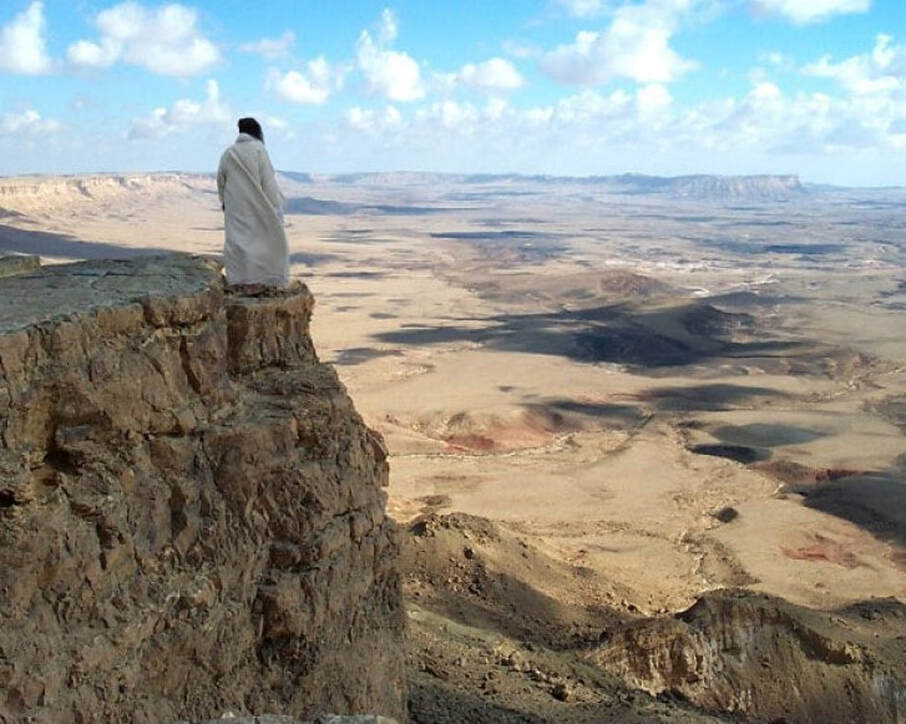|
26/2/2022 Ash Wednesday 2022: Into the Wilderness “And behold, thou wert within me, and I out of myself, where I made search for thee!” (St Augustine). This Lent, I am heading for the Judean Desert. Not in body (although I would dearly love to), but in spirit. I have long been fascinated by the unescapable presence of the wilderness in the Old and New Testaments, permeating the Bible as vividly as do any of the Biblical characters. It is always there, its vastness and barrenness a stone’s throw from the habitable world. 'Wilderness' in the Bible refers mainly to two distinct locations: the Sinai Desert, where the Hebrews wandered for 40 years after the exodus from Egypt, and the relatively bare, uncultivated area in the south of the Promised Land known as the Negeb, or Judean Desert. The desert is a place of contradictions – stark, barren, and terrifying. “The great and terrible wilderness” is both a place of trial and of deliverance, of purgation and illumination. Abraham passed through the desert at least twice on his immense migratory journey. This is the place where the wanderings of Moses and his people culminated in the birth of Israel as a nation; here David found refuge from Saul; here the Essenes escaped Hellenistic domination of Jerusalem; here the Zealots made their final, desperate last stand at Masada against the might of Rome; and here John the Baptist prepared for his mission. In the desert Elijah, deeply discouraged, longed for death - but it was here that God came to him in the still, small voice. This is the place where the original scapegoat was sent (Levit 16:10), carrying the sins of the people on his back; and it was to the desert that Jesus – who carried all our sins - was driven by the Spirit. One of Christ’s paradoxical sayings is that we have to lose our life to save it. Equally, we have to go where there are no paths in order to find our direction. The wilderness, or desert, is the ultimate trackless zone. In the Bible it is a place of transformation and revelation. This “howling wilderness waste” (Deut 32:10), swept by deadly winds (Is 21:1; Jer 4:11), is at the same time a holy place, where the glory of God descended upon Moses “like a devouring fire” (Ex 24:17). Passage through the wilderness was an integral part of their mission for Abraham, Moses, John and Jesus. But where is such a place to be found in a modern suburban life? In our frenetic, noisy, peopled world, where are we to find these great stark tracts of silence and isolation, these testing grounds with their lurking dangers of heat and thirst and wild beasts? Where are we to find a place where we strip away everything that is superfluous, everything that distracts us or deadens us, and place ourselves utterly in God’s hands? To find the answer, I plan to retrace the desert journey – sometimes with Abraham, Moses and John – but especially with Jesus, since it is above all in his life that we seek the meaning of our own. The more I read the Biblical accounts, the clearer it became that the journey is metaphorical as well as literal. The wilderness exists on maps, but it also exists within us. For many of us, our “selves” are like haunted houses – tenanted with the ghosts of past loves and losses, triumphs and disappointments, achievements and failures. Sorrows and rage as old as infancy can lurk within us and the accumulation of a lifetime’s shortcomings can make our “selves” uncomfortable and unwelcoming places in which to be, so that we try to spend as much time as possible outside ourselves. We fill our days with noise and activity; sometimes we deaden our pain with alcohol, food, work, sex or drugs. An Episcopal monk and spiritual writer, Martin L Smith, describes our habitual condition as one of being under an anaesthetic: “Most of us have a primary defence mechanism against being overwhelmed by the pain of the world and our own pain. It is as if we administer to ourselves an anaesthetic to numb its impact. The price we pay is that it also numbs our capacity for joy, but until we surrender to the Spirit of God we reckon the price to be worth it.” (Martin M Smith, A Season for the Spirit, London 1991, p.21). Extreme youth or extreme age does not excuse us from making the journey into the wilderness. John the Baptist appears to have entered the desert at a very young age, in preparation for his mission as the Forerunner. Abraham – then known as Abram - was 75 years old when he received that irresistible call “Go from your country and your kindred and your father’s house to the land that I will show you” (Gen 12:1). It is almost never too late to make this journey, although the longer we leave it the harder it becomes. Our distractions, addictions or avoidances grow like tumours around vital organs. If we leave the tumours untreated, we die. The longer we wait to remove them, the more potentially deadly the operation. If we don’t confront the wilderness inside, we can never overcome our own isolation. If we don’t sufficiently accept and love ourselves, we can never really enter into communion with others and with God. Was this what St Augustine was getting at when he cried “And behold, thou wert within me, and I out of myself, where I made search for thee!” Comments are closed.
|
AuthorHelen Gallivan is co-founder with John Dundon of New Pilgrim Path. This blog is adapted from ther book, Dawn without Darkness, published by Veritas. Archives
April 2022
Categories |
 RSS Feed
RSS Feed